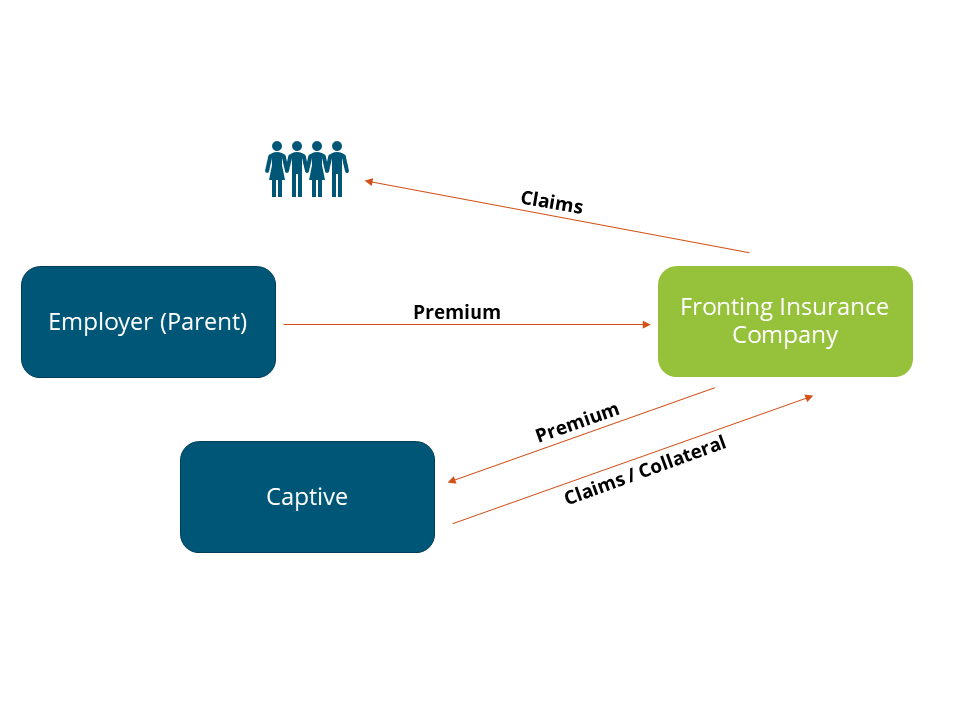As seen in Captive Insurance Company Reports (CICR)
For most companies today, its people are one of the largest investments its makes. COVID-19 accentuated this point and further showed us how the health of a company depends in large part on the health and wellbeing of its workforce. Providing competitive benefits is not just the right thing to do, but a sound business decision. Employee benefits usually account for one of the largest expense line items on an income statement for organizations. In a world where employee benefits consistently become both more important and more expensive, businesses of all types are looking for an affordable mechanism to finance these risks. One solution that has become central to discussions about employee benefits has been captive insurance.
To provide some background, a captive is an insurance or reinsurance company – which can help insure or reinsure the risks of its owners, the parent company (or companies).
Employee Benefits & Captives
Over the past decade as healthcare and benefit costs have been rising, captives have become the go-to solution for organizations looking to bend the healthcare cost curve as well as create a more efficient employee benefits program. More recently, however, organizations are recognizing the many qualitative advantages of a captive that can help attract and retain employees- a company’s most import asset. As we enter a new decade, these qualitative advantages or “soft costs” of human capital will drive the next iteration of captive insurance.
Traditionally, captives have been viewed as purely a funding mechanism for employee benefits that provides the following advantages:
- Improved cost savings
Cost savings can be yielded through: better control of premium costs, reduced frictional costs (commissions, taxes, insurer profit, administration), captured underwriting savings, earned investment returns, and improved cash flow for the parent organization.
- Improved risk management & increased control
- Enhanced reporting: Captive programs usually provide reporting in a more timely manner, allowing stakeholders to make decisions regarding potential plan design changes for the upcoming year.
- Centralized risk pool: From an organizational risk perspective, leveraging a captive allows risk managers to have a more complete understanding of the risks associated with the programs. Also, life and disability lines are usually considered to be third party risks and have a positive impact on the captive’s risk distribution.
- Non-correlated risk: Employee benefits usually add non-corelated risk for existing captive programs, thereby, reducing the risk exposure to the captive.
- Quantification of loss prevention programs and wellness initiatives: By utilizing a captive, the organization has the ability to implement data analytics programs that provide actionable insights on the effectiveness of existing programs and the current cost drivers.
- Design coverages and provisions for programs that are unique to the parent company: Every organization has a unique set of risks and captives can be used to fill in gaps in the existing benefit programs.
In our view, the next generation of captive insurance will have a sharper focus on the soft costs of human capital, such as:
- Intangible results
While employee benefits account for large costs for employers, they are running a significant risk by not providing the right benefits. By establishing a captive, employers can open doors to focus on human capital and the more qualitative aspects of a program. Further, a captive allows for customized benefits programs to meet the needs of your unique demographic. Employees a technology company will have different priorities and expectations than, for example, those that work in manufacturing. With a captive you can understand and meet those unique needs better than you could with a commercial carrier, in a cost-effective manner. This will go a long way with retention and engagement, and will make your employees feel their voices are heard.
Another intangible result of a captive program is the parent organization’s ability to capture enhanced data analytics. This data comes in months sooner than it would with a commercial carrier, meaning you can analyze your programs and make real-time decisions to yield better claims results. For example, if you know one of your biggest population health issues is diabetes, you can establish programs to address diabetes before your renewal is up. With commercial carriers, the information comes in too late to make changes for that plan year.
Which Benefits Can I Fund Through a Captive?
A wide range of employee benefits may be funded through a captive – the most common coverages are Medical, Life, Disability, Retiree Medical and Voluntary Benefits.
Captives can be used to fund Employee Retirement Income Security Act (ERISA), or non-ERISA benefits. ERISA benefits are primarily the benefit plans sponsored by and contributed to by employers. Life and Disability plans are usually ERISA in nature. These plans are subject to federal oversight, under the auspices of the Department of Labor (DOL) and require express approval from the DOL to fund them in a captive. Approval from the DOL is subject to meeting certain criteria – using an A rated fronting carrier, not paying any more than market rates for the coverages, no direct commissions as part of the contract, requirement for an indemnity contract, to name a few.
Medical stop-loss is usually not considered to be subject to ERISA and has become an extremely popular benefit to add to a captive. The reason for this has been two-fold. Firstly, the rising cost of catastrophic claims. Self-insured organizations are increasingly concerned about the financial impact of high-cost claims – unfortunately seeing $1M or $2M claims is becoming commonplace. One such large claim could have a material impact on the financial sustainability of the program. Second, the hardening insurance market is driving employers of all sizes towards a captive based stop-loss solution, as it reduces the opaqueness of the pricing process and helps employers get a much clearer understanding of their premiums and cost drivers. Usually a captive stop-loss program involves the employer creating an annual aggregate limit, and purchasing excess coverage from the commercial markets above the captive’s aggregate retention. Thereby, protecting the captive from most catastrophic claims.
Long-tail benefits such as group universal life insurance and long-term disability are ideal captive candidates. Benefits that pay out over multiple years (e.g. long-term disability and retiree medical), provide cash flow stability and loss predictability.
Using a captive for voluntary benefits has recently risen in popularity. This is a cost-efficient way of offering benefits that your employees can choose to participate in, or not. More and more employers are turning to this strategy as healthcare becomes more expensive, as a way to supplement benefits and lessen both their financial burden and the financial burden faced by their employees. One of the most attracting elements of writing voluntary benefits into your captive is that voluntary benefits typically have a very low loss ratio, which means they can generate a lot of savings within a captive. Those savings can then be leveraged to reduce premiums for employees or expand the coverage offered. An example of a prime voluntary benefit often offered in a captive structure is hospital indemnity, which can be critically helpful coverage, but one that is often otherwise too expensive to fund.
How it Works
Unlike property and casualty lines of coverage, employee benefit lines have a unique value proposition. They allow organizations to recapture dollars that would have otherwise gone to an insurance carrier. Both life and disability coverages use a fronted carrier, i.e. a commercial carrier stands in front of the captive so that from an employee perspective there is no change in the way they interact with the insurance company. On the back end, the carrier cedes risk and premiums to the captive.
The following illustrates how a typical fronted captive program works.

Under such an arrangement the fronting insurer to continue to administer the program. The employer pays the fronting insurer an annual fee for its services, allowing the captive to retain underwriting profit (if any) from the program. Depending on the risk appetite of the organization and the results of the actuarial modeling – the employer may choose to buy reinsurance for the program.
In Closing
The typical steps involved in adding benefits to an existing captive or forming a new captive are a feasibility study which outlines qualitative and quantitative factors for consideration, such as potential savings, program structures, design alternatives, insurance considerations, and implementation requirements.
Today those in the insurance industry are facing difficult circumstances on a variety of fronts. The recent pandemic has led to hardening of markets. We are seeing substantial rate increases for clients. Captives offer a solution to mitigate these increasing costs in a sustainable manner. In addition, captives provide access to additional data and insights that can help organizations get a clearer understanding of claims drivers and therefore allow for implementation of solutions and tools that reduce claim costs. Further, captives provide organizations the ability to impact the soft costs of human capital by identifying and crafting unique solutions to meet their employees’ needs, more important now as the pandemic shed light on gaps in coverage many did not realize existed.
Captives are useful and versatile risk financing tools, especially for employee benefits. They provide significantly better cash management than can be provided through a trust and can produce impressive cost savings as compared to fully insured guaranteed cost plans.
We hope we’ve piqued your interest and we’re here for you. Over the next months, we will dive further into employee benefits captives to cover things like types of captives, moving to a self-insured program, medical stop-loss, feasibility studies, solutions for small and mid-sized businesses and more. We hope you’ll keep reading.
Spring has been awarded by Employee Benefits Advisor for this Rising Stars 2020 award! Check out the full article here.
Our Senior Consulting Actuary, Peter Johnson has been selected for Business Insurance’s 2019 Break Out Awards! Check out this quick Q&A with Peter that gives insights into his background.
and this is one of the many reasons I love my work. One component of my role is assisting organizations in managing their disability and leave programs, which includes being compliant with the American’s with Disabilities Act (ADA) and Amendments Act (ADAAA). The ADA has pained employers for years due to its regulatory complexity, and although they are making strides and building functional processes to address it, it can sometimes feel like two steps forward and one step back.
I recently conducted a training on the ADA for a large employer team of subject matter experts. After a challenging week of what felt like personal parental fails, I used an analogy that managing your ADA program is a lot like raising a pre-teen! Truth be told, that wasn’t in the script, but it was top of mind at the time and I knew that most of the audience could relate to both parental and ADA struggles.
If you still aren’t convinced of the overlap, I have outlined four challenges with the ADA (that I also experienced with my 12-year-old daughter).
1) Everything must be managed on a case-by-case basis
Organizations must have a prescribed process to identify and manage ADA cases to ensure potential accommodations do not slip through the cracks. However, the regulation is clear in that every case must be reviewed based on its own merit. Employers must consider every request, examine what is needed, and consider solutions that will satisfy the employee’s needs without causing undue hardship to the organization. Key elements of any job must be considered, such as location, essential functions, organizational structure, hardship potential, duration and the like. A simple yes or no is rarely enough. There are often conditions that must be met, including the potential for extensive negotiation, and any decision may be accompanied by resistance from different parties.
At home I also take into consideration things like location, duration, hardship to the family unit and every request must be reviewed on its own merits. Just like with your ADA requests, a yes is always met with delight, but a no will always cause additional work and difficult discussions. That said, that doesn’t mean that you can routinely go the “yes” route just because it’s the path of least resistance.
2) There is a constant demand for “things”
Regardless of whether the request is for Instagram or a sit-stand desk, the requests just keep rolling in! Giving a simple “no” just isn’t going to work. You must engage with your employee (or child) by asking questions, digging into the details, justifying your rationale and following documented policies and regulations (or family rules). Why do they need what they are asking for? Examine both sides of the argument.
With accommodation requests, a simple “yes” is rarely the optimal solution. The key is to really understand what is needed versus what is requested, as there are often gaps in between. The dialogue and documentation need to support what the employee can do and what will ensure they are able to do the essential functions of their job with or without accommodations. Simply approving their request for something may not actually yield a successful solution. Instead as the employer you need to fi nd an accommodation that suits not only the employee but as many stakeholders as appropriate. I recently worked with a client surrounding parking accommodations which were on the rise and extremely challenging given their various office locations and distances to sites. It highlighted how a simple “yes” doesn’t always work. Instead great care needs to be taken with each request and each potential accommodation.
With my daughter it started with an iPod and grew to the iPhone, which has now turned into social media requests. Just saying yes doesn’t work for me – I need to dig in and see what I can provide her that might satisfy her need to fi t in without creating an undue hardship for me. And if I do say yes, you can bet there is going to be a social meeting agreement (similar to an accommodation agreement) to hold us both accountable!
3) Your voice is drowned out by others
Employees requesting an accommodation typically have resources to work with at an organization. They may be working with a disability or workers’ compensation partner, their supervisor, HR, benefits and even occupational health resources. All those voices become noise in the ADA process. Even with the best of intentions, those sources put pressure on the situation that may drown out the voice of the accommodation team. Some parties may be encouraging return to work too aggressively or not aggressively enough. Silence from those resources may be perceived as lack of support the same way that vocalization may be viewed as intimidating. How do you fi nd the right balance?
The key is to manage expectations within the ADA process and bring the stakeholders together by giving them a seat at the table. The interactive process is a very critical part of accommodation reviews; it cannot be avoided in a compliant process. Instead of dreading that part of the process, try to embrace it. Use it to get to the best solution for the employee and the stakeholders and then make a firm decision on what can be implemented.
All parents understand that our children aren’t always listening to us even though we may think every word we utter is critical and wisdom-filled (just like a strong HR professional). Further, what they hear from us may differ from what they hear from their friends, friends’ parents, teachers, or even your spouse. But regardless of the frustration or eyerolls, the ultimate decision related to our children rests with us. They may try to change our minds or tell us all the reasons why other opinions should be valued, but we determine the best solution and do our best to implement it at home.
4) Everything must be managed on a case-by-case basis
An organization cannot be compliant with the ADA, or appropriately manage absence, unless they are dedicated to developing an accommodation program and following through with clear processes and documentation. With that said, it is a long game – a marathon, not as print. Most employees and supervisors will not be singing your praises immediately. At first, they will feel like you are making it “too easy” for employees, or “rewarding” employees who are abusing the system. At the same time employees may think you are “asking too many questions” or “forcing them to pay more money to get paperwork completed.” On any given day all those things may be true, but you are also working to provide a compliant work environment that accommodates employees fairly. You want a solution that returns employees to productive work, processes that are in good faith and interactive and a way that documents what steps were taken and what was agreed to. All of those are beneficial to your organization and to the individual as well.
I was recently working with a client that learned the hard way about documentation. They had a healthcare resource that was given an accommodation around not performing CPR as it was not viewed as an essential function. This employee was transitioned to a new role where CPR was required but the knowledge of her accommodation and lack of ability to perform this function was missed during transition. Unfortunately, this placed an unanticipated strain on the organization, which could have been avoided with greater documentation. Instead, the involved parties were working to solve the immediate need without thinking about the long-term impact on the employee or the organization.
As you focus on return to work and accommodations, try to aim for incremental change toward the most successful program possible, keeping the long-term vision in your view. Start with your policies and procedures, ensuring they reflect the type of program your organization needs. Consider them as living documents that will require revisions as your accommodation program matures. Build an efficient process around those policies, doing your best to move toward that pre-defined,
distant goal post.
At home, incremental change is necessary as well. Do I want a clean room, laundry done, dishes finished and homework perfect? Yes. But I will settle for incremental change toward a successful and productive member of society. This may mean taking things one step (or chore) at a time or placing more focus on the achievements compared to the gaps.
So next time my daughter tells me I am “annoying” and “all the other kids have Instagram” and “I don’t know what it’s like,” I will remind myself that on any given day those things may be true, but I’m trying to raise a healthy, happy kid and building this foundation is necessary to create long-term success. Right now, it’s hard for me to see the goal post but I know it’s there.
Regulation around the ADA is complex, like my pre-teen, but it’s important to remember that it is built on the core premise of avoiding discrimination and pushing employers to do what is right. It sometimes forces a difficult dialogue between employers and employees, but the goal is optimal for both parties.
Whether you’re an office manager, business owner, or a human resource or benefits professional, renewing your company’s health insurance plan may become automatic. Considering alternatives is a daunting task that many feel they lack the bandwidth to handle. However, at a time when healthcare costs are rising, the market is in flux, and employees are expecting more and unique benefits, choosing the most convenient option is probably not your best bet.
It’s imperative to routinely review your package, your results and rethink your strategies to make sure you’re minimizing your costs while giving employees the best coverage at a reasonable rate. You may think you’ve considered everything, but you probably haven’t. Before your renewal date, make sure to address the following questions.
1) Does your medical trend align with market standards?
Before you renew, take a hard look at the medical trend being used this year for next year’s renewal. The market has been seeing downward trends, so you’ll want to make sure you’re seeing that in your rates. For2019, renewals are in the low single digits.
2) If you’re self-insured, have you considered medical stop-loss?
While advantages of self-insurance include flexibility and savings opportunities, self-insured companies are also exposed to an extra level of risk – unexpected, catastrophic loss that they’re expected to cover themselves. Stop-loss insurance, sometimes called catastrophic insurance, can help mitigate this risk. Medical stop-loss is coverage specific to healthcare spend, and involves the establishment of a threshold by the employer over which they have external coverage for.

With an uncertain future for US healthcare, medical stop-loss is something all self-insured organizations should include in their program. Employers will need to consider where the stop-loss program attaches to make sure you don’t over or under purchase coverage. Also, captive stop-loss solutions should be considered to maximize your savings, providing a savings of 10% or more on your stop loss spend.
3) Do you have the right tools in place to support and communicate benefits with your employees?
You may have an impressive health plan and competitive benefits offerings, but if your employees aren’t aware of them, don’t know how to utilize them, or fi nd them irrelevant, you’re not going to see the results you’re hoping for.
It might be time to give these questions some thought:
- How and when are you telling employees about what’s available to them?
- Do they truly understand their options?
- Do you know what benefits your workforce finds most valuable? Are you giving them what they want, or what you think they want? Think about your demographics here.
- Do you have streamlined processes for benefits administration, claims fi ling, etc.?
Consider a formal or informal survey of employees to fi nd out what is working and not working. Further, there are a number of administrative tools, such as Bswift, that you may want to evaluate. For compliance and HR initiatives, ThinkHR and like platforms may be appropriate.
4) Is it time to consider an actuary?
An actuary is a certified professional that measures and predicts insurance risks and premium rates. They are math-based risk experts and can help organizations with insurance policy development, forecasting, valuations, audits, and more.
Most small businesses believe they have no need for actuarial services. However as organizations grow and consider more advanced and varying insurance options, the greater the need for an actuary becomes. While the work of an underwriter is crucial, actuaries take a deeper look at the numbers. They are a neutral third party, and can offer crucial information such as how much volatility you can expect over a one and five-year period. These insights allow you to make smarter insurance decisions.
5) Could your organization benefit from alternative funding strategies?
If you’re fully-insured, have you thought about aiming for a self-funded structure? If you’re self-insured, have you thought about a captive insurance company? If you’re a small businesses, have you thought about an Association Health Plan (AHP)?
We recommend thinking about these alternatives every couple of years. As businesses change and grow, along with market regulations and options, what once made sense for an organization may no longer be the best fi t.

Captives provide unparalleled transparency of and control over an insurance program, which helps with cost savings and customization. Once only an option for jumbo-sized employers, more and more smaller organizations are utilizing a captive structure, either as a standalone captive or part of a cell or group captive.
Further, the AHP market is expanding quickly, due in part to new regulations passed earlier this year. This is a great avenue for a small business to benefit from economies of scale and get the same rates as a large employer. For more information about how to set up or join an AHP, please get in touch.
Healthcare is complicated, but with that complexity comes new and exciting opportunities. Before you decide to maintain the status quo and renew your plan, take some time to think about what’s truly best for your organization and its workforce.
A recent report from AM Best concluded that, based on their ratings, captive insurance companies outperformed commercial market carriers yet again in 2017. This finding was based on a hard look at balance sheet strength, operating performance, and business profiles of captives as compared to their commercial counterparts.
As long-time captive consultants, we’ve seen a range of clients benefit from a captive structure and are well-versed in their advantages. The AM Best report is a testimony to the positive role captives can play and how they’re able to provide a competitive edge to the organizations using them. Some of the key advantages include:
1) Homogeneous Risks
Whether a Single Parent Captive or a Risk Retention Group (RRG), the insureds of a captive are going to have similar risk profiles and diversity. A Single Parent Captive insures the parent company, so all its risks belong to one entity. RRGs are made up of like companies with similar missions and business products/services, such as a group of universities. In both cases, the homogeneity of risk will benefit the captive by establishing a certain level of predictability which helps with the consistency of rates and an unsurprising loss ratio.
2) Underwriting Profit/Results
According to AM Best, the Captive Insurance Composite (CIC)experienced a 86.4% five-year combined ratio, while the Commercial Casualty Composite (CCC) had a 99.9% five-year combined ratio. Captives enjoy such underwriting profits for a number of reasons, primarily the fact that risk management, control, prevention and mitigation are all at the heart of the captive’s purpose. Organizations are able to benefit from their own good experience. Captives facilitate transparency and more access to data. This allows organizations to act in a proactive manner and implement risk mitigation and control protocols in an almost real time basis. Comparatively, a fully insured commercial market policy may result in a delayed information transition – most commercial insurance arrangements provide reports a quarter after year-end. In addition, frictional costs are lowered with a captive.
3) Return on Investment
A major advantage that organizations with captives have over commercial carriers is the opportunity to recapture part of the premiums. Captives require capital infusion to start and get off the ground. The profits/savings from the insurance carrier accumulate in the captive and can, over time, begin to yield impressive returns on investment. Most feasibility studies use an internal rate of return or a hurdle rate to help visualize potential savings. This makes captives a great alternative for deploying capital and earning a consistently positive return on income, in addition to being able to use it strategically for reinsurance purposes.

Another pro of captives is the ability to evaluate their ROI evaluated against their hurdle rate as their internal rate of return. A company can determine if an investment will give them adequate benefit or savings over a given timeframe based on their rate of return, and then decide if that investment is worth following through with, or if another solution is more economically sound.
These factors combined allow captives a healthy sum of capital and positive balance sheets.
4) Competitiveness
Commercial carriers are sometimes unable to understand the true needs of the insureds and are limited in their offerings. Captives create competitiveness in the market and can compel commercial carriers to offer better terms and costs by virtue of a captive’s existence. In many instances, commercial carriers are threatened by the captive’s ability to take on all the risk and become willing to create quota share arrangements. Captives are a unique, tailored solution for the insured(s)and offer an unbeatable level of customization and very little changes in premiums. They have the ability to insure unique risks and are able to fill in the gaps of coverage where commercial markets are unable to do so.
5) Enterprise Risk Management
AM Best defines Enterprise Risk Management (ERM) as, “establishing a risk-aware culture and using tools to consistently identify and manage, as well as measure risk and risk correlations.” An organization that utilizes a captive is likely to have a stronger ERM system in place, when compared to its captiveless peers, since it is partaking in its own experience and thus is more motivated to better manage its risks. Inmost cases, the captive is a vital cog in the ERM wheel. This close alignment allows for better results for both parties, and a lower total cost of risk for the captive.
6) Retention
Many rated captives have a retention rate of 90% or higher. This is, in part, because policyholders are routinely rewarded through dividend payments from the captive that are significantly higher than any seen in the commercial market. These profits can be used in a multitude of ways to further benefit the captive. For example, policyholders could underwrite additional lines of coverage without the need for more capital, or provide premium holidays on programs, or fund FTEs.
This, combined with the lack of competition means that captives don’t need to shop around for business each year, creating savings in acquisition costs which can then be returned to the captive (e.g. in the form of loss control) to further benefit the insureds.
7) Ability to Identify Emerging Risks

A captive’s structure and foundation in ERM gives it an added advantage of foreseeing emerging risks. Typically, all key stakeholders and the entire risk team of an organization will be involved in the captive’s management and activity. Having a strong alignment between the parent company, the captive, the IT team, the risk experts, the actuaries and other main players means that everyone is on the same page. A captive can make long-term assessments while also flagging and resolving issues quickly. There is no fragmentation of knowledge in a captive setup, and all stakeholders have the same interests. In sum, captives allow organizations to be nimble and react to changing market conditions quicker than commercial market carriers.
Conclusion
As AM Best states, captives performed well in 2017, as did RRGs, and it’s projected that success will continue into 2018 and beyond. The US captive market has grown substantially over the past few years, with domiciles like North Carolina and Hawaii experiencing an uptick in captive formation. Further, we’re seeing captives being used more frequently for nontraditional lines of coverage, such as cyber and medical stop-loss, adding to the list of use cases.
Captives are a great tool for insureds to create unique, custom-made solution in partnership with the commercial markets. They facilitate better management of claims – their expenses and adjustments –through accurate estimations.
Lastly, one of a captive’s most important attributes is its flexibility and ability to be swift and proactive, without the typical issues in a commercial insurance relationship.
The term voluntary benefits was coined long ago when employers fully funded (or significantly subsidized) core benefits and voluntary benefits were an add-on, paid for by the employee through payroll deductions. As the landscape changed, core benefits evolved to be partially funded by employers and partially funded through payroll deductions. As a result, many benefits became voluntary.
For today’s employees, it’s not as simple as core and voluntary; it’s about choice. Employees need to balance what limited disposable income they have for all benefits, regardless of what they are labeled. Even still, the concept of core and voluntary resonates with employers as an industry norm, so it’s important to identify ways to avoid common pitfalls of voluntary program implementation:
- Think holistically
- Don’t forget about ERISA
- Consider enrollment options as a critical component in overall design
- Remember that education is key
- Help employees get the most from their plan
1) Holistically About Voluntary Benefits
Many employers think offering voluntary benefits is like checking a box – something that can be done quickly and without much deliberation. However, programs without thoughtful preparation are rarely successful in terms of education, enrollment and satisfaction. Voluntary benefits should be considered an integral part of the overall benefits package. A strong offering should take into account various factors, including but not limited to:
Current population:
Although a one-size-fits-all approach does not and should not exist, employee demographics can help you pinpoint which products would be most sensible for your collective audience. Generally speaking, those that are starting out in their careers have different priorities than those nearing retirement, and employees falling somewhere in the middle of the spectrum will have their own set of benefits needs as well. For example, accident insurance is more popular for families than for singles or empty nesters, while student loan repayment is more relevant for those in their 20’s and 30’s than for older employees.
Current benefit offering:
When considered in tandem, voluntary benefits can serve to protect employees and reduce their risk or perceived risk for various physical or financial troubles. For example, introducing a high deductible health plan offering complementary voluntary products (i.e. hospital indemnity, critical illness, accident insurance) can help decrease the financial burden on employees.

2) Don’t Forget About ERISA Considerations for Voluntary Benefits
Voluntary benefit programs may or may not be subject to the Employee Retirement Income Security Act of 1974(ERISA), depending on how they are structured and supported by the employer. ERISA provides important protections but can also pose constraints for employers and employees. Assuming you do not want your voluntary programs to be covered under ERISA, you must be careful to manage enrollment and administration separately from your core benefit programs. If you would like your voluntary plans to be subject to ERISA, then coordinating administration and enrollment will not be problematic; however, understand the potential impacts. ERISA compliance and your potential fiduciary duties should never be an afterthought.

3) Consider Enrollment Options as a Critical Component in Overall Design
Our research affirms that employees better understand the offering
and have higher enrollment when they participate in group meetings or individual meetings. In addition, vendor partners are often willing to offer more competitive pricing and waive enrollment requirements if they can meet with employees directly or send them some type of material in the mail.
While some employers welcome the “free” education and enrollment, others are concerned about aggressive selling or having employees using work hours to meet with potential vendors. If you think of voluntary benefits as part of your holistic offering, then leveraging work hours will be less of an apprehension when voluntary is an element of your complete attraction and retention tool.
The key is to think about the enrollment process as an essential design component of your voluntary program. Ensure that decisions surrounding enrollment fi t with the overall program strategy and make sense for your population. Providing comprehensive enrollment with core and voluntary may be a best practice for your group. This allows employees to make coordinated decisions regarding their contributions and programs. It also enables you to offer complementary plans for optimal plan selection. While that structure works for some, other employers feel employees have too many decisions to make during annual enrollment and prefer to stagger voluntary enrollment to allow more time for thoughtful decision making. There’s no right or wrong answer – each company and population is different.
4) Remember that Education is Important
Decision support tools have continued to evolve, providing employees with strong advocacy for traditional plans and voluntary benefits alike. Although voluntary benefits are designed to be less complex and easier to understand, for some employees the language is new. Summarizing the program(s) and sharing scenarios to help employees understand the products is often the best way to introduce a new plan.

Regardless of who funds the program, as the employer it is important that you educate your employees on the available offering. Employees should not elect a benefit they do not understand and employers should not offer benefits that are not valued by employees, or that employers themselves cannot explain effectively. Every dollar spent on voluntary benefits is money your employees are not spending on other necessities like monthly bills, student debt, groceries, emergency savings, or even401k contributions; make sure they are knowledgeable about what they are buying and ensure that it’s a competitive product in the market.
Education can be facilitated in many ways including traditional employee meetings, brochures, benefit fairs, and onsite sessions with vendors. At Spring we have also assisted clients with quick videos that provide the highlights of a program and generate interest. These videos have been well received and employees are able to retain the information from a creative video more easily than a detailed presentation. Videos are also shareable and can be viewed by family members who may be a critical part of the decision-making process.
5) Help Employees Make the Most of the Plan
After you have implemented a voluntary program and educated your membership it’s important that you continue to monitor the program and assist your employees in optimization. Sometimes employees forget about the benefits they have available to them and continue to make monthly contributions to plans but they neglect to fi le claims because they don’t remember what they have elected. A few simple actions can help your employees make the most of the plan:
- Send a quarterly newsletter to all employees, or just those enrolled in voluntary benefits. This will give you the opportunity to remind them of the program benefits. It can also help facilitate changes (i.e. enrolling spouses, children) and provide an opportunity to as questions.
- Partner with your vendors. For example, if you have a purchase program in place, they often run specials and send postcard reminders. Take advantage of those specials! Perhaps you could run a joint wellness campaign linked to specials on health equipment. Ask if they would be willing to raffle off something like a treadmill or vacation to align with your wellness strategy.
- Remind your employees to file claims. Even if you cannot leverage actual data, you can send a reminder at the midpoint of every year for wellness visits with a link to the claim form. For example, most critical illness and accident plans offer a wellness rider – find out how many employees use that benefit and try to increase that percentage.
- Ensure the program remains competitive from a pricing and design standpoint. Employees should feel assured that the benefit they’re purchasing through their employer remains is top tier.

Taking the above factors into account will help you establish a voluntary benefit offering that is accessible and relevant to your employees and that is well worth the effort on your part. Today’s workforce has come to expect more than just the basics when it comes to benefits, and voluntary products allow you to diversify your benefits package, keeping you competitive with market standards without any significant cost increase.
However, it is not enough merely to offer voluntary products and services – they need to be the right ones for your population, they need to be communicated effectively, they need to be readily understood, they need to account for regulations like ERISA, they need to be fully utilized and they need to be rolled out in a way that makes sense for your organization. By covering these bases you’ll be able to avoid the most common pitfalls and successfully offer a valued voluntary benefits programs.